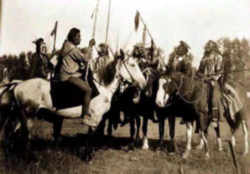


Colorado Early History
First Early Inhabitants of Colorado

Early history examines the archaeological record that tells the story of the first inhabitants of Colorado. Learn about the prehistory and culture of the first early inhabitants, and what lessons it might teach us about the early history of Colorado.
Colorado First Early Inhabitants Timeline
- 12000 BC - In 2004 archaeologists in Kansas working near the Colorado-Kansas border reported radiocarbon dating results finished in February that showed mammoth and prehistoric camel bones dating back to about this time.
- 1500 BC - Earliest inhabitants of Colorado were known as the Basket Makers.
- 500 BC - Other Native Americans, ancestors of the Pueblo, entered the area and most probably intermingled with the Basket Makers.
- 350 BC - The Anasazi were probably living in Colorado caves. Their present name comes from a Navajo word meaning "the ancient ones" or "the ancient enemy." First evidence of humans in southwest Colorado: corn pollen. Nomadic hunter-gatherers planted crops in the spring, then left to forage and hunt over the summer, returning in the fall to harvest and seek shelter in caves for the winter. They made baskets of yucca fibers, sometimes waterproofed with pitch from piñon pine.
- 1 to 1299 AD - Advent of great Prehistoric Cliff Dwelling Civilization in the Mesa Verde region.
- 550 AD - Native peoples in southwest Colorado began building pit houses. Found the world over, these are rooms dug in the ground with roofs of mud and logs. To get in or out, people used a ladder through a hole in the roof that doubled as a smoke vent-unpleasant for humans but a good way to keep animals out. You can see several excavated pit houses at the National Park.
- 600-1300 AD - Pueblo Indians built their Cliff Palace at Mesa Verde.
- 750 AD - Native peoples in southwest Colorado started building stone houses above ground, first one-story, then two. Ruins of these are scattered over the landscape and have the look of ones the Pueblo Indians-Hopi, Zuni and others-of the Southwest live in today. Added beans, an important source of protein, to their diets, and began making simple grayware pots. Had bows and arrows.
- 1150 - A group of Anasazi villages in southwest Colorado were suddenly abandoned during a period of severe drought. In 2000 evidence showed that a raiding party had swept through the area, killed the inhabitants and ate their flesh.
- 1200 - The Anasazi in southwest Colorado began building their cliff dwellings at Mesa Verde about this time. The population thrived here for about 70 years making corrugated pottery and handsomely decorated black and white pottery.
- 1250 - The Anasazi in southwest Colorado fought a battle against unknown enemies. Number of kivas built greatly increased. Quality of workmanship in building decreased. People began to leave.
- 1276 to 1299 - A great drought and/or pressure from nomadic tribes forced the Cliff Dwellers to abandon their Mesa Verde homes.
- 1300 - Mississippian culture period of Mound Builders
- 1500 - Colorado is the homeland of the Ute Indian tribe
- 1682 - French Explorer Rene-Robert Cavelier, Sieur de La Salle, claims Colorado for France
Early History of Native Americans in Colorado
The Indigenous People of Colorado
The Southwest cultures were adopted by the Apache, Pueblo, Zuni and Navajo. The Plains culture was adopted by the Apache, Arapaho, Cheyenne, Ute, Shoshone tribe, Comanche, Pawnee and Kiowa.
The earliest inhabitants of Colorado were known as
the Basket Makers. They arrived in the region around 1500 BC and were primarily nomadic hunters. The Basket Makers developed a sophisticated practice
of basket making, and they created waterproof containers by covering baskets with clay and baking them.
Gradually, the Basket Makers developed farming practices and raised corn and squash. By 500 BC, other Native Americans, ancestors of the Pueblo, entered
the area and most probably intermingled with the Basket Makers. Later inhabitants, probably the Anasazi Indians, who included the cliff dwellers who
built multi-storied stone houses in the alcoves of canyon walls in the southwestern corner of Colorado. At the end of the thirteenth century, these
Indians abandoned their cliff dwellings and apparently moved southward.
When Spanish explorers came to the area in the 16th century, they found many different tribes of Native Americans. The Ute inhabited the mountain valleys, while the Comanche, Cheyenne, Arapaho, and Kiowa lived in the Great Plains region. Warfare between these groups of early inhabitants was continuous. Eventually, the Plains Indians combined forces in an attempt to stop the invasion of their homelands by white settlers.
Today, most of the state's Native American population is found on the Southern Ute reservation in the Denver area.





